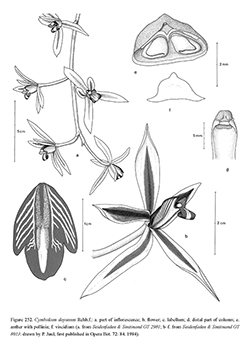e-Flora of Thailand
Volume 12 > Part 2 > Year 2014 > Page 451 > Orchidaceae > Cymbidium
6. Cymbidium dayanum Rchb.f.wfo-0000934360
Gard. Chron. 1869: 710. 1869; Seidenf., Opera Bot. 72: 82, fig. 45, t. Vc. 1984; Du Puy & P.J.Cribb, Gen. Cymbidium: 159, fig. 38(3), 87–90, t. 15, map 19. 2007. Fig. 252.
Accepted Name : This is currently accepted.
Synonyms & Citations :
Description : Epiphytic herb. Pseudobulbs ca 4 by 2.5 cm, fusiform, slightly bilaterally compressed. Leaves 5–8, sessile, 40–95 by 0.7–1.6(–2.4) cm, linear-elliptic, slightly obliquely acute to acuminate, thickened and coriaceous, dark green, the mid-vein prominent below. Inflorescence 18–30 cm long, peduncle short, suberect to horizontal, with 5–15 flowers; bracts 2–10 mm long. Flowers 4–5 cm across; not usually scented; sepals and petals white or cream with a central maroon stripe that does not reach the apex, rarely suffused wine-red; labellum white, with an orange or yellow spot at the base; side lobes white, veined maroon, with a maroon margin; mid-lobe deep maroon with a basal, triangular, pale yellow stripe that does not reach the apex; ridges white or cream. Dorsal sepal 25–34 by 6–8 mm, narrowly elliptic to oblong-lanceolate, acute or shortly acuminate, margin slightly erose towards the base, erect; lateral sepals similar, oblique and pendulous. Petals 18–28 by 5–7.5 mm, narrowly oblong to elliptic, obtuse to acute, apiculate, porrect and tending to cover the column. Labellum 15–22 by 10–15 mm when flattened; side lobes as long as the column, with porrect, triangular tips subacute at the apex and minutely papillose; mid-lobe 8–12 by 7–9 mm, recurved, ovate, entire, subacute, mucronate to acuminate, minutely papillose, often with minute hairs towards the base and with 2 lines of longer, often glandular, hairs extending from the ridge apices to the centre of the mid-lobe; ornaments of 2 parallel ridges extending from the base of the labellum to the base of the mid-lobe, covered in glandular hairs. Column 11–14 mm long; pollinia 2. Capsule 4–6 by 1.5–2 cm, ellipsoid.
Thailand : NORTHERN: Mae Hong Son, Chiang Mai; NORTH-EASTERN: Phetchabun, Loei; EASTERN: Nakhon Ratchasima; SOUTH-EASTERN: Chanthaburi.
Distribution : N India [Sikkim, Assam (type)], Bhutan, Myanmar, S China, Taiwan, Ryukyus, Japan, the Philippines (Luzon), Cambodia, Peninsular Malaysia, Sumatra, Borneo (Sabah); 1,200–1,600 m alt
Ecology : Epiphyte in hollows on the limbs and trunks of trees or on rotten logs or humus-covered rocks in evergreen montane forests, often in full sun. Flowering: August–November.
Vernacular : Karekaron khao (กะเรกะร่อนเขา), karekaron pak daeng (กะเรกะร่อนปากแดง).

